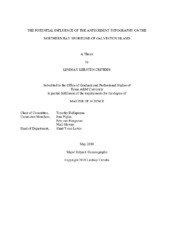| dc.description.abstract | The objective of this study was to determine if the antecedent Pleistocene topography
influenced the geomorphic features and evolution of Galveston Island and West Galveston Bay
(WGB). Antecedent Pleistocene topographic features were identified by mapping the
Pleistocene/Holocene unconformity within WGB using high resolution marine geophysics and
sediment cores. This study found three incised-valleys that extend beneath Galveston Island,
from east to west: 1) Highland Bayou Incised-Valley, 2) Carancahua Incised Valley and Eastern
Halls Bayou Incised-Valley, and 3) Western Halls Bayou Incised-Valley and Chocolate Bayou
Incised-Valley. The accommodation space created by the valleys acted as an obstacle the island
had to overcome, filling with sediment as it grew westward. The incised-valleys reside beneath
the island exhibiting unique geomorphic features (frequency of storm surge channels,
embayment size, presence of beach ridges and overwash) generally not found on the island not
underlain by incised-valleys. The Pleistocene surface contains Deweyville Terraces (−9 m and
−9.5 m), providing evidence the incised-valleys formed in conjecture with the Trinity River
Incised-Valley.
The measured shear strength of Beaumont Formation sediment was 5-17.5 times higher
than the Holocene fill. The Beaumont Formation is indurated and extremely resistant to erosion,
whereas the Holocene fill is relatively uncompacted and highly susceptible to erosion. As a
result, the Holocene filled valleys undergo differential compaction, causing enhanced
subsidence, making them geotechnically weak zones and susceptible to the formation of storm
surge channels and embayments.
The initial formation of storm surge channels along the bay shoreline of Galveston Island
began concomitant with the initial formation of Galveston Island, when it was in a narrower,
regressive phase where overwash and breaching were common. The island width reached a
critical threshold where breaching was no longer possible, increasing to a width of 1,200 m
around 3,300 yBP. This is discerned by beach ridges of this age that have never been breached
by overwash channels. The PBR flowed through the western half of WGB from 4,000-6,000
yBP, but Carancahua Reef provided a barrier preventing it from flowing into the eastern half of
WGB. After the PBR changed course, its sediment ceased to be deposited in WGB. | en |


